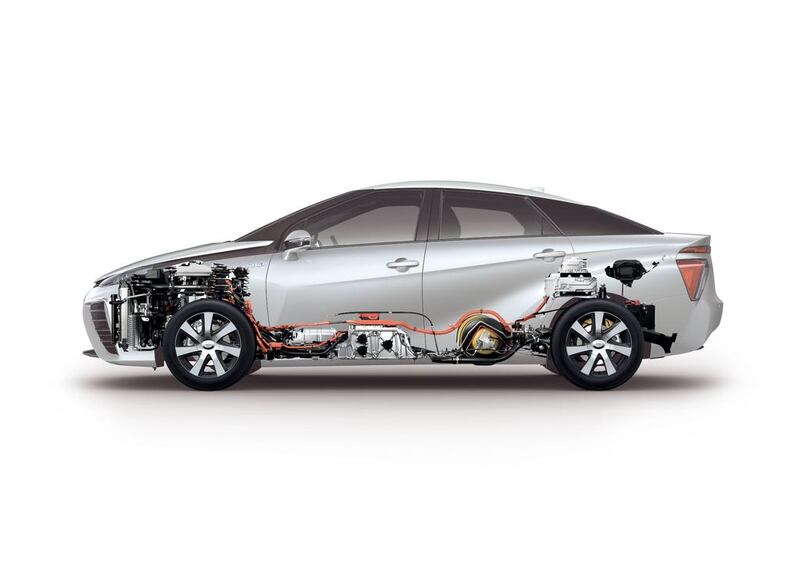With the world's governments agreeing on a plan for the future of the planet at the COP 21 summit in Paris, all that's left to do is meet the emissions targets set in the climate deal. Easy.
Well it would be if the world’s motorists all replaced their petrol- and diesel-fuelled cars with vehicles using alternative power sources. That, however, will take some time: at the moment, for example, only 4 per cent of the vehicles in the European Union use hybrid or alternative fuel, while the proportion is 4.8 per cent in the United States.
Toyota was the first carmaker to push the hybrid message, while the number of electric vehicles (EVs) on the market has also been increasing in recent years, which is really starting to shake up the established manufacturers. In the meantime, plug-in hybrid electric vehicles (PHEVs) are the halfway house that manufacturers are currently staking their metaphorical mortgages on.
And now there’s hydrogen fuel-cell vehicles (FCVs). In recent months, both Hyundai and Toyota have launched cars that use this new technology, which we have previously only seen in limited-run vehicles such as the Honda FCX Clarity and BMW Hydrogen 7.
Fuel-cell cars work by using the hydrogen stored in tanks in the car and combining it with oxygen from the air in the fuel cell – which is, in essence, an electrochemical energy-conversion device – where a chemical reaction takes place that produces electricity. This is used by a motor – which also uses energy from a battery that draws it from regenerative braking – to drive the vehicle’s wheels.
I’ve spent time behind the wheel of the Hyundai ix35 Fuel Cell and the Toyota Mirai, and the experience of driving them is surprisingly familiar in many ways. Yes, the almost complete silence is unlike a car with an internal combustion engine and more like an EV, but the fact that you can spend a few hours in one without worrying about running out of juice enables you to just get on with driving it. Neither car is particularly engaging to drive, but that makes it resemble a large proportion of mass-market cars currently on sale, so there’s an immediate sense of familiarity. But the big question is whether this technology is a viable alternative to internal combustion engines or just a futuristic flight of fancy?
The development of hydrogen cars has come about because they offer a number of advantages. For example, hydrogen, as a substance, is available in abundance all around us, in every molecule of water (which covers 71 per cent of the surface of our planet) and natural gas.
Then there’s the fact that hydrogen is three times more energy efficient than petrol: internal combustion engines use about a fifth of the chemical energy contained in petrol, whereas fuel cells can use about 60 per cent of the energy available in hydrogen.
But the big advantage – the one that gives it immediate appeal in the context of concerns about climate change – is the fact that there are no harmful emissions, either in its creation (if it’s produced using electrolysis using electricity from renewable sources, such as solar or wind power) or as a by-product after its use in a fuel cell. Indeed, the only emissions from hydrogen fuel cell vehicles come in the form of water.
You also add to the mix that FCVs can travel more than 450 kilometres on a single tank of fuel, look and feel much like conventional vehicles to drive (and refuel), and you have a car that motorists can switch to without too many concerns about learning to drive a new type of car, or any of the “range anxiety” plaguing the take-up of EVs.
So that all looks pretty straightforward, and you might now be wondering where you sign to become a fully paid-up member of a hydrogen economy that was predicted as far back as the early 1970s – especially if you consider the benefits of integrating hydrogen into a smart energy grid that combines the sustainable generation of electricity and its storage in the form of hydrogen.
There are a number of obstacles to attaining this energy utopia, however. Aside from the not-insignificant issue of the huge development costs of a hydrogen economy (and who will foot those costs), there are a number of other concerns.
The first is the production of hydrogen, because there’s a difference between hydrogen, the actual chemical element, and hydrogen as a fuel: the atom is widely available, but the fuel needs to be produced. Currently, about 50 million tonnes of hydrogen are produced globally each year, mostly via a process that involves extracting it from methane (called steam-methane reforming), which is expensive and doesn’t offer sufficient environmental benefits. Ideally, we need to build integrated wind-to-hydrogen plants, involving the electrolysis of water (extracting the “H2” from H20, in other words), but the costs will be significant, and require governments around the world to get involved with grants or incentives, at the very least.
The next issue is the storage of the hydrogen produced – for use in FCVs, it has to be stored as a gas, which requires high-pressure tanks – and the fact that it has to be 99.999 per cent pure.
Then there’s distribution. Countries that already have hydrogen filling stations only have a handful (for example, 10 in the US – all in California – and three in the United Kingdom). The construction of a network of new hydrogen stations in the US would cost an estimated US$20 billion (Dh73.46bn); and in the EU, about $4.6 billion.
But despite the problems with hydrogen as a fuel, perhaps the biggest issue that faces hydrogen fuel-cell cars is that they seem redundant at a time when EVs and plug-in hybrids are starting to become more practical alternatives.
To put it bluntly, why spend billions on developing ways to store energy in the form of hydrogen, then using that hydrogen to produce electricity for a motor, when electrical energy is available via sockets and charging stations to be stored in the batteries of EVs?
And for that matter, why use renewable energy from solar panels, wind farms or hydroelectricity to create hydrogen, when you can cut out the middle man and use that power directly to charge EVs? That said, most EVs are unlikely to be charged with “green” electricity in the foreseeable future, while fossil-fuel-burning power stations continue to be the go-to option for the generating industry. But if a more carbon-neutral direction is the way we start to go after the new COP 21 agreement, the argument holds up.
If we also factor in the advances that are being made into battery technology – the Tesla Model S also has a theoretical 480km range – and the time it will take for the hydrogen project to become established (even Toyota thinks the Mirai is the start of a 20-year march towards viability), perhaps this will end up as a cul-de-sac in automotive history.
That would be a shame, because hydrogen has a lot of offer as a sustainable source of energy, but at the moment there’s a real danger that fuel-cell vehicles could end up as the car industry’s equivalent of Betamax video recorders.
motoring@thenational.ae





